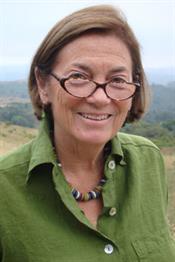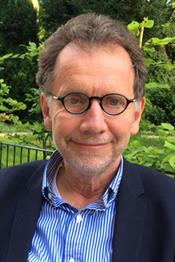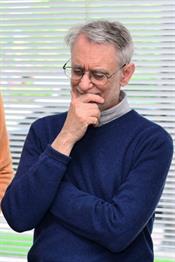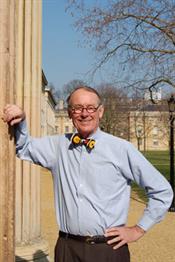-
Membership
Membership
Anyone with an interest in the history of the built environment is welcome to join the Society of Architectural Historians -
Conferences
Conferences
SAH Annual International Conferences bring members together for scholarly exchange and networking -
Publications
Publications
Through print and digital publications, SAH documents the history of the built environment and disseminates scholarship -
Programs
Programs
SAH promotes meaningful engagement with the history of the built environment through its programs -
Jobs & Opportunities
Jobs & Opportunities
SAH provides resources, fellowships, and grants to help further your career and professional life -
Support
Support
We invite you to support the educational mission of SAH by making a gift, becoming a member, or volunteering -
About
About
SAH promotes the study, interpretation, and conservation of the built environment worldwide for the benefit of all
Society of Architectural Historians Announces 2019 Fellows
Jan 7, 2019
by
SAH News
The Society of Architectural Historians is pleased to announce the 2019 class of SAH Fellows. Dolores Hayden, Dietrich Neumann, David Van Zanten and Richard Guy Wilson will be inducted as Fellows of the Society of Architectural Historians on Thursday, April 25, 2019, during the SAH 72nd Annual International Conference awards ceremony in Providence, Rhode Island. SAH Fellows are individuals who have distinguished themselves by a lifetime of significant contributions to the field of architectural history, such as scholarship, service to SAH or stewardship of the built environment.
In congratulating the 2019 SAH Fellows, SAH Executive Director wrote, “We at SAH are delighted to honor four scholars who have approached the history of the built environment from vastly different perspectives for a great many years to the benefit of us all. From Hayden’s groundbreaking work on feminist architectural history to Neumann’s innovative interpretations of modern icons, and from Van Zanten’s existential questions about the nature of Western architecture to Wilson’s embrace of the public through exhibitions, television series, and legendary summer programs, we are honoring four individuals who have had an incredible impact on our field. Their creative approaches to interpreting the history of the built environment are an inspiration to us all and will continue to be inspirational for decades to come.”
Visit sah.org/fellows for more information and a list of past SAH Fellows.
 Dolores Hayden
Dolores Hayden
Dolores Hayden, professor emerita at Yale University, writes about built environments and the politics of place. Her work has spanned architecture, landscape architecture, urban planning, and American cultural history as she has pioneered the analysis of vernacular buildings and landscapes to explore larger political questions about gender, class, and race. Her award-winning books on the contested history of cities and towns include Seven American Utopias (MIT Press, 1976); The Grand Domestic Revolution (MIT Press, 1981); Redesigning the American Dream: Gender, Housing, and Family Life (W.W. Norton, 1984, rev. ed. 2002); The Power of Place: Urban Landscapes as Public History (MIT Press, 1995); Building Suburbia: Green Fields and Urban Growth (Pantheon, 2003); and A Field Guide to Sprawl (W.W. Norton, 2004). In Los Angeles in the 1980s and 1990s, she founded and directed The Power of Place, a non-profit that developed a downtown itinerary of livelihoods to promote historic preservation and public art on sites important to the economic history of women and people of color. Hayden was educated at Mount Holyoke College; Girton College, Cambridge University; and the Harvard Graduate School of Design. Over the years, she taught at MIT, UCLA, and UC Berkeley as well as Yale, and won fellowships from the Guggenheim Foundation, the Rockefeller Foundation, the Radcliffe Institute, the ACLS/Ford Foundation, the NEH, the NEA, and the Center for Advanced Study in the Behavioral Sciences at Stanford. Recently she served as president of the Urban History Association and has received career awards from the Beverly Willis Architecture Foundation, the American Planning Association, and the Society for American City and Regional Planning History. Her current project, a third collection of poems, Exuberance (Red Hen Press, forthcoming May 2019), explores risk and excitement in the voices of female and male stunt pilots from the early years of American aviation.
 Dietrich Neumann
Dietrich Neumann
Dietrich Neumann is a professor of the history of modern architecture and director of the Urban Studies Program at Brown University. He was trained as an architect in Munich, Germany, and at the Architectural Association in London and received his Ph.D. from Munich University. He writes on modern European and American architecture and has organized a number of traveling exhibitions. His books have dealt with the history of skyscrapers, movie set design, architectural and urban illumination, Richard Neutra’s Windshield House on Fishers Island and the Empire State Building (a children’s book). He has just finished a study of the genesis and critical reception of Mies van der Rohe’s Barcelona Pavilion (Princeton University Press, 2019) and is working on a Mies biography (Yale University Press, 2020), as well as publications on George Nelson and Raymond Hood. Recent essays have addressed the reception of Frank Lloyd Wright in 1920s Germany, the political dimension of street lighting in Berlin and urban scenery in Fritz Lang’s movie, Metropolis. An interest in public humanities led to the creation of smart phone apps about campus architecture at Brown University, IIT and MIT.
Dietrich Neumann has won fellowships at the Centre Canadien d'Architecture in Montréal, the Institute for Advanced Study at Princeton, the American Academy in Berlin and the American Academy in Rome. He was the first Vincent Scully Visiting Professor at Yale and is a member of the Committee on Architecture and Design at the Museum of Modern Art. He won the 1996 Founders’ Award and the 2003 Philip Johnson Exhibition Catalogue Award, both from the Society of Architectural Historians. He co-organized three SAH study tours to Germany, served as the local co-chair of the SAH 2004 annual conference in Providence and is serving as local co-chair for the SAH 2019 annual conference in Providence. He is currently managing the Rhode Island content for SAH Archipedia, the Society’s online encyclopedia of US architecture. He served twice on the SAH Board of Directors and as its president from 2008 to 2010.
 David Van Zanten
David Van Zanten
David Van Zanten works on modern Western architecture, focusing especially on design methods and the architect’s social sense of him- or herself. He was trained at Princeton, initially as an architect early in the teaching career there of Michael Graves, then at Harvard in art history, with a year at the Courtauld Institute studying the extraordinary Romanesque Cathedral at Saint Albans under George Zarnecki. In the late 1970s and early 1980s he served summers as an archeological architect at Cosa, near Rome, and Sardis, near Izmir, Turkey. He has taught at McGill University, the University of Pennsylvania and, since 1980, at Northwestern University, retiring in 2018. He served as secretary of SAH from 1978 to 1982 and on the Board of Directors from 1974 to 1977.
His dissertation (Harvard, 1970) explored the fascinating efforts to understand the implications of traces of painted color on Greek temples reflected in the work of Gottfried Semper and Owen Jones, J.-I. Hittorff, Henri Labrouste and Félix Duban (Garland: [with an up-dated introduction], 1977). His Paris work he expended in his Designing Paris (MIT Press, 1987), which was awarded the 1988 Alice Davis Hitchcock Book Award from SAH, and Building Paris (Cambridge, 1994). Parallel Chicago is summarized in his Sullivan’s City (W. W. Norton, 2000). He has contributed to the exhibitions The Architecture of the Ecole des Beaux-Arts (MoMA, 1975), The Second Empire (Paris, Philadelphia, Detroit, 1978–1979), Chicago Architecture, 1872–1922 (Chicago, Paris, 1987–1988), Louis Sullivan: The Function of Ornament (St Louis Art Museum, 1986), as well as several exhibitions at the Block Museum of Art at Northwestern University. He has twice edited volumes presenting the work of the Chicago/Australian/Indian designers Walter Burley and Marion Mahony Griffin (1970, 2011). He has been awarded a Fulbright, a Graham Foundation Fellowship, two NEH Fellowships, a DAAD, and a Guggenheim. He is a Chevalier of the French Ordre des Arts et Lettres (1995) and a Fellow of the American Academy of Arts and Letters.
Looking back over these research experiences, he sees two great questions yet to explore: 1) Focusing on just how architects “produce” building designs, where this activity might fit in our Western social matrix, and 2) Considering architecture, therefore, a medium and a stance in our culture—what happens when certain architects explore its conceptual edges? – Jones, Labrouste and Hittorff; Sullivan and Wright; Kahn, Venturi and Graves.
 Richard Guy Wilson
Richard Guy Wilson
Richard Guy Wilson’s architectural journey began in Los Angeles—the home of everything new—in a house designed by the leading modernist Rudolph Schindler for his parents. The journey continued with Riverside’s Mission Inn and then side tracked with the University of Colorado and the US Navy. The architectural adventure returned with his marriage to the wonderful Ellie, a student of Bill Jordy’s at Brown, and then a Ph.D. at the University of Michigan in 1972 under Leonard K. Eaton. The architectural adventure really got going with teaching at Iowa State (1972–1976), and then the University of Virginia where he holds the Commonwealth Chair. More architectural awakenings came with summer programs—39 years for the Victorian Society—and commentator for PBS and A&E television. Wilson’s scholarship includes architecture and design from the 17th to the 21st centuries. In addition to articles, reviews, papers and talks he is the author/joint author of 16 books and catalogues with titles such as McKim, Mead & White, Architects, The Colonial Revival House, and Edith Wharton at Home, and Buildings of Virginia: Tidewater and Piedmont, a volume in the Society of Architectural Historians’ Buildings of the United States series. A real adventure has been major museum exhibitions such as The American Renaissance, 1876–1917, The Arts and Crafts Movement in America, The Machine Age in America, Tiffany’s Laurelton Hall, The Making of Virginia Architecture, The Architecture of R.M. Schindler and 3 exhibits on the architecture and design of Thomas Jefferson. Books on Jefferson’s career and on Louis Comfort Tiffany are in progress. A most important part of his architectural journey are the colleagues and extraordinary students: undergrads, graduates, and those interested in the history of the built environment. These individuals have made this adventure in architecture possible, and it will continue.


